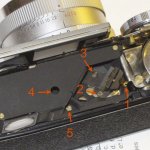Brett, the aperture is stuck wide-open. When I have the shutter open on bulb, I can see a bit of movement behind the shutter blades when I turn the aperture ring to automatic and then back to the numbers. The ring is such that the A is next to f/22 and f/1.8 is furthest away from the A. When the shutter is closed, movement of the aperture ring from A to f/1.8 doesn't make any noise (except for the click stops); however, when I have the shutter open on bulb, moving it to the f/1.8 results in a "tink" sound and moving it onto the A makes a sound as if something is getting tripped. The only time I see (what I think are) the aperture blades move is when I move it from A to f/1.8 (but not from f/1.8 to A). Also, the tink and the trip sounds only occur if I go from one A to f/1.8 and back. If I move from A to f/8 and back, no trip sound. If I move from f/1.8 to f/8, no tink sound.
Hi Tony,
from what you've said it would seem the aperture blades may still be sticking. This isn't so surprising, because in the process of cleaning and firing the shutter blades, no matter how careful you are, it is almost inevitable that you'll flick a bit of goo onto the aperture. My Contaflexes tend to often do this when I clean them. And they may have been oily, anyway, before you started...
There are a couple of things you could try (because we have to think laterally and remember that there are other things that might malfunction apart from the shutter itself).
Firstly, you might try putting the control in Auto mode, and selecting a longer shutter speed. This may encourage the aperture to close when you fire the camera if the meter is pointed to a bright light source, as, if it is functioning, it will try to stop down the lens. Increase the ASA setting if you need to, to increase the feed from the meter and give it a helping hand.
If this makes no difference, it may be wise to leave the camera to dry out for a couple of days, just to ensure no naptha residue is making the blades stick. Often the wetness of the lighter fluid will make sticking parts such as the aperture move, when they're stuck, but not always. You can always feed it a drop of naptha in a day or two, to see if this encourages some movement of the aperture, but, it's probably easier to let it dry properly first, in case this helps.
There are other options, of course, such as taking the top off the shutter to manipulate the mechanism manually and close the aperture. But as I mentioned, not having personally looked inside one of these shutters myself, I have not read good things about dismantling them. Hence, I would suggest less intrusive options in the first instance.
Unfortunately, a lot of the online information about these camera is in Japanese, however if you also do a bit of Googling, you'll turn up some more details about this and at the least, some useful pictures. From what you've posted so far, the interior of the top certainly looks similar to the late 1950s early 1960s Fujicas such as the 35-EE & 35-SE.
Regards,
Brett


